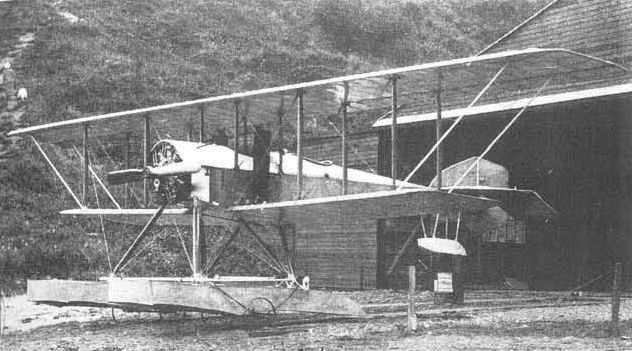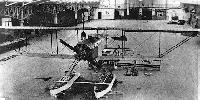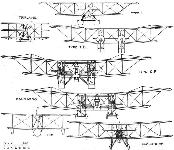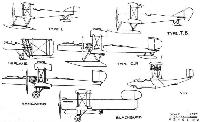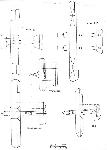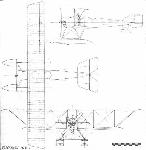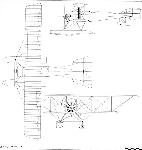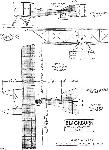A.Jackson Blackburn Aircraft since 1909 (Putnam)
Blackburn Type L
Both in the United Kingdom and on the Continent, 1912 had been a year marred by fatalities caused by the structural failure in the air of monoplanes and as a result the British Government banned them from service with the RFC. A departmental committee was set up to enquire closely into such accidents and although its report, issued early in 1914, 'saw no reason to recommend the prohibition of the use of monoplanes', the ill-advised ban, though temporary, created prejudice in favour of biplanes that was to last for close on two decades.
Blackburn monoplanes, rugged and reliable, experienced none of these failures, but nevertheless Robert Blackburn considered it expedient to follow the popular trend and in 1913 designed a two-seat 'hydro biplane' on twin floats, to be powered by either an 80 hp Gnome or a 100 hp Anzani. It was to have had unequal span and cruise at 65 mph at an all-up weight of 1,250 lb, but when, in 1914, the Daily Mail announced a ?10,000 prize for a Circuit of Britain seaplane race, the project was dropped and a larger, more powerful version built. Designated Type L, it was the company's first biplane and the first Blackburn aircraft since the First Monoplane to have a square instead of triangular-section fuselage. Four ash longerons converged rearwards until they were all bolted to the rudder post and, as before, internal bracing was by precision-fitted diagonal wooden struts instead of the wire bracing favoured by other manufacturers.
Although the component parts of the Type L were fabricated at Balm Road, the seaplane itself had the distinction of being the first of the many hundreds of aircraft assembled in the disused roller-skating rink known as Olympia in Roundhay Road, Leeds, which had been acquired as a new works in the spring of 1914, just prior to the firm's expansion into a limited company. The aircraft was powered by a 130 hp Canton-Unne nine-cylinder watercooled radial, an engine of Swiss origin, named after its co-designers, and built under licence in Britain by the Dudbridge Iron Works Ltd at Stroud, Glos. Money was distinctly scarce at this time and Robert Blackburn was only able to proceed with the Type L through the kindness of Dudbridge's Mr Kimmins who provided an engine on exceptionally favourable terms. It gave full power at 1,250 rpm and was cooled by two radiators mounted vertically on each side of the front seat. An aluminium cowling over its upper part extented rearwards to form a curved decking which concealed the 32-gallon main fuel tank mounted on the top longerons between the cockpits. There was also a partitioned tank behind the engine holding five gallons of oil and an additional 16 gallons of fuel. The pilot sat in the rear cockpit, where the end of the main fuel tank sloped slightly forward to form an instrument panel carrying revolution counter, altimeter, compass and clock. Controls were conventional and similar to those of the Improved Type I, with a rudder bar for directional control and a large aileron wheel mounted at the top of a tubular control column.
Fabric-covered, wooden mainplanes constructed in the usual Blackburn manner were rigged unstaggered in two bays and the considerable top wing overhang was supported by sloping struts. Long-span ailerons were fitted only to the upper mainplanes, with the balancing cables running through pulleys mounted on its upper and lower surfaces. Tail surfaces were similar in outline to those of the earlier machine but rudder area was increased by a large horn balance under the rear end of the fuselage.
The twin wooden floats were of unusual design with two steps, the first being only some two feet from the front end. Up to this point there was a pronounced vee bottom which gradually lessened until, aft of the second step, the bottom of the float became quite flat although concave in side elevation. Each float was clipped to tubular steel spreader bars and attached to the fuselage by six stout ash struts. Buoyancy at the tail was provided by a small float attached to four short steel tubes.
The Circuit of Britain seaplane race attracted nine entries from the Sopwith, Beardmore, Grahame-White, Eastbourne, White and Thompson, Avro and Blackburn companies, the Type L, which was to have been flown by Sydney Pickles, receiving racing number 8. Considering the power loading of over 19 lb/hp, its prospects appeared good, the top speed being over 80 mph, and the range of 445 miles was exceptional for those days. Competitors were scheduled to start from Calshot at 6 am on Monday, 10 August 1914, and to Proceed via Ramsgate, Great Yarmouth, Scarborough, Aberdeen, Fort George, Oban and Kingstown (Dublin) to Falmouth but entries were actually on their way to the starting point when war was declared against Germany. The race never took place and all the competing aircraft were commandeered by the Admiralty.
The Type L was taken to a section of beach north of Scarborough known as Scalby Mills where Blackburns had built a large wooden hangar. There it was used for offshore reconnaissance duties, thereby forging a link between the company and the Royal Navy that remains unbroken to the present day. The pilot was Sydney Pickles, who had flown the Improved Type I monoplane earlier in the year, and it seems that he experienced control and cooling problems, as it was found necessary to replace the long-span ailerons by shortspan, wide-chord, inversely-tapered units which extended well behind the trailing edge of the upper mainplane; to remove the engine cowlings and move the radiators back to the rear centre section struts; and to fit a curved, wide-bladed airscrew. The aircraft was then armed with a machine gun, probably a Lewis, and spent some six weeks at Scarborough in the care of Blackburn mechanics, but its Service career was brief. Early in 1915 the company's test pilot, W. Rowland Ding, struck the top of the cliffs at Specton in poor visibility while en route from Scarborough to RNAS Station, Killingholme. The undercarriage was wiped off and the rest of the airframe became a total loss in the ensuing crash.
Proposals made late in 1914 for an even larger naval development of the Type L, having staggered mainplanes and powered by a 200 hp Gnome, were shelved.
SPECIFICATION AND DATA
Manufacturers: The Blackburn Aeroplane and Motor Co Ltd, Olympia Works, Roundhay Road, Leeds, Yorks.
Power Plants:
(1913 project)
One 80 hp Gnome
One 100 hp Anzani
(Type L) One 130 hp Canton-Unne
(1914 project) One 200 hp Gnome
Dimensions, Weights and Performance:
1913 project Type L 1914 project
Span upper 44 ft 0 in 49 ft 6 in 62 ft 0 in
lower 36 ft 0 in 35 ft 0 in 47 ft 6 in
Length 33 ft 0 in 32 ft 6 in
Height 12 ft 6 in
Wing area 410 sq ft 481 sq ft
Tare weight 1,250 lb 1,717 lb 1,450 lb
All-up weight 2,475 lb 3,000 lb
Maximum speed 65 mph 81 mph
Climb
to 5,000 ft 34 min
Ceiling 11,000 ft
Range 445 miles
Production: One aircraft only, Type L, impressed by the Admiralty August 1914, crashed at Speeton, Yorks., in 1915.
Показать полностью
M.Goodall, A.Tagg British Aircraft before the Great War (Schiffer)
Deleted by request of (c)Schiffer Publishing
BLACKBURN Type L seaplane
After preparing a seaplane project in 1913, Blackburn proceeded with the design of a large 'hydrobiplane' for entry in the 1914 Seaplane Circuit of Britain. This was Blackburn's first biplane and the first to be built at the Olympia Works. When the contest was abandoned the Type L was commandeered by the Admiralty and moved in August to Scalby Mills, where it was tested and flown by freelance pilot Sydney Pickles. It was operated for a period on coastal reconnaissance, armed with a machine gun. Early in 1915 the machine crashed into a cliff at Speeton in poor visibility, when being flown by Rowland Ding from Scarborough to Killingholme.
The Type L was a conventional biplane design of the period, although it was the first Blackburn machine with a square-section fuselage. During the course of its development, the longspan, parallel ailerons on the top wing were replaced by shortspan, tapered units. Other changes included the removal of the engine cowling and the moving of the radiators to the rear center section struts.
A proposed larger development of the Type L was not proceeded with.
Power: 130hp Salmson (Canton-Unne) nine-cylinder water-cooled radial.
Data
Span top 49ft 6in
Span bottom 35ft
Chord. 6ft
Area 481 sq ft
Length 32ft 6in
Height 12ft 6in
Weight 1,717lb
Weight allup 2,475lb
Max speed 85 mph
Ceiling 11,000 ft
Range 445 miles
1913 Project.
Power: 80hp Gnome seven-cylinder rotary or 100hp Anzani ten-cylinder both air cooled.
Data
Span top 44ft.
Span bottom 36ft
Chord 5ft
Area 410 sq ft
Length 33 ft
Weight. 1,250lb
Max speed estimated 65 mph
1914 Project.
Power: 200hp Gnome Monosoupape nine-cylinder air-cooled rotary.
Data
Span top 62ft
Span bottom 47ft 6in
Weight 1,450lb
Weight allup 3,000lb
Показать полностью
J.Bruce British Aeroplanes 1914-1918 (Putnam)
Blackburn Seaplane Type L
THE first biplane to be built by the Blackburn Company was a two-seat tractor floatplane which was designed to participate in the 1914 Daily Mail “Circuit of Britain” seaplane race. The machine was allotted the racing number 8, and was to have been flown by Sidney Pickles, but the outbreak of war prevented the contest from taking place. In common with several of its contemporaries the Blackburn machine, which was designated Type L, was taken over by the Admiralty. For war service it was, somewhat surprisingly, fitted with a machine-gun.
The Type L was a handsome two-bay biplane with strut-braced extensions on the upper wing; ailerons were fitted to the upper wing only. The fuselage represented a breakaway from earlier Blackburn practice, for it was of rectangular cross-section, whereas all the monoplane antecedents of the Type L had had fuselages of triangular cross-section. The main longerons were of ash, and the fuselage structure embodied no wire cross-bracing: rigidity was obtained by the use of diagonal wooden members. The fuel tanks were mounted under the rounded top decking: in front of the pilot (who occupied the rear seat) was a tank containing 32 gallons of petrol, and in front of the passenger there was a divided tank which held five gallons of oil and sixteen of petrol.
The machine was powered by a 130 h.p. Salmson water-cooled radial engine, the radiators for which were mounted outside the fuselage on either side of the front cockpit.
The most noteworthy feature of the Type L lay in the design of its floats. Each float had two steps, the forward one of which was remarkably near the bow. The forward portion of each float had a vee bottom which gradually flattened out towards the second step, aft of which the bottom was flat but the lower line of the float was slightly concave in side elevation.
The tail-unit was of typical Blackburn outline. The rudder was balanced, but the balance area was below the fuselage. All control cables were duplicated.
It seems that the Type L did not see any real war service, despite its impressment by the Admiralty. It was taken to Scarborough and remained there for some six weeks; during that time it was apparently maintained by Blackburn mechanics. Early in 1915 it was taken up by Rowland Ding, the well-known pre-war pilot who became a Blackburn test pilot. During this flight it flew into a cliff and was wrecked.
SPECIFICATION
Manufacturers: The Blackburn Aeroplane & Motor Co., Ltd., Olympia, Leeds.
Power: 130 h.p. Salmson radial engine.
Dimensions: Span: upper 49 ft 6 in., lower 35 ft. Length: 32 ft 6 in. Chord: 5 ft 9 in. Gap: maximum 6 ft. Stagger: nil. Dihedral: upper nil, lower 2°. Incidence: 40. Span of tail: 11 ft 6 in. Distance between float centres: 8 ft 3 in.
Areas: Wings: upper 294 1/2 sq ft, lower 186 1/2 sq ft, total 481 sq ft. Ailerons: each 21 sq ft, total 42 sq ft. Tailplane: 37-25 sq ft. Elevators: 24 sq ft. Fin: 5-75 sq ft. Rudder: 13-25 sq ft.
Weights: Empty: 1,717 lb. Loaded: 2,475 lb.
Performance: Maximum speed at sea level: 81 m.p.h.; at 10,000 ft: 64 m.p.h. Climb to 5,000 ft: 34 min. Ceiling: 11,000 ft. Endurance: 5 1/2 hours.
Tankage: Petrol: 48 gallons. Oil: 5 gallons.
Armament: One machine-gun, presumably a Lewis, fired by the passenger.
Показать полностью
P.Lewis British Aircraft 1809-1914 (Putnam)
Blackburn L
For the 1914 Circuit of Britain Race organized by the Daily Mail, the Blackburn Company broke away from its predilection for the monoplane and built its first biplane. The necessity for providing adequate support for the lower wings, and also a strong anchorage for the float struts, brought about a further departure from the traditional Blackburn triangular fuselage and resulted in a normal rectangular section being used. This was of fairly broad aspect, to give smooth lines to the fuselage by accommodating the diameter of the 130 h.p. Salmson (Canton-Unne) radial engine which was chosen to power the machine. Although the engine was a radial, it was water-cooled, and the accompanying radiators were mounted in an upright position on each side of the front cockpit.
Wire tie-bracing was omitted, its place being taken by diagonal wooden members. The two-bay wings were of comparatively broad span, and the upper extensions were strut-braced to the bases of the outer pairs of inter-plane struts. Yet another departure from earlier Blackburn practice was the provision of long-span ailerons, instead of warping, which were fitted to the upper wings. Two main floats, incorporating two steps each and set well apart, and a plain tail float, comprised the landing-gear.
The Type L was entered as No. 8 in the Circuit of Britain contest, and the well-known pilot Sydney Pickles was selected to fly the machine in the race. The imminence of war brought about the abandonment of the competition and when the conflict broke out on 4th August, 1914, the seaplane in common with several other aircraft was taken over by the Admiralty and was taken to Scarborough, remaining there for about six weeks. A machine-gun was fitted to it, but the end of the sole Type L came when it was flown into a cliff by W. Rowland Ding early in 1915, subsequently being abandoned as irreparable.
SPECIFICATION
Description: Two-seat tractor biplane seaplane. Wooden structure, fabric covered.
Manufacturers: Blackburn Aeroplane Co. Ltd., Olympia, Leeds.
Power Plant: 130 h.p. Salmson (Canton-Unne).
Dimensions: Span, 49 ft. 6 ins. Length, 32 ft. 6 ins. Wing area, 481 sq. ft.
Weights: Empty, 1,717 lb. Loaded, 2,475 lb.
Performance: Maximum speed, 81 m.p.h. Landing speed, 45 m.p.h. Endurance, 5.5 hrs.
Показать полностью
H.King Armament of British Aircraft (Putnam)
Blackburn Seaplane Type L. During 1915 this aircraft is said to have been armed with a machine-gun (presumed Lewis) for service with the RNAS, and an early Blackburn document states that it was originally designed to meet the requirements of a coastal-patrol seaplane, with an observer gunner forward and the pilot behind. The same document mentions a load of two '165-lb' bombs (presumed 65-lb), though it is doubtful if these were ever carried.
Показать полностью
Jane's All The World Aircraft 1913
BLACKBURN Aeroplanes. Blackburn Aeroplane Co., Balm Road, Leeds. Blackburn produced his first machine early in 1910 (see 1911 edition for details). In the latter part of that year he designed the machine which ultimately developed into the Blackburn military. In 1911 other types were produced, all being fitted with the patent Blackburn triple control. School at Filey. Hucks has been the principal Blackburn flyer. The type has also been very successfully flown by naval officers. Capacity of works: about 24 a year.
1912-13 1912-13 1913.
Military. 2-seater. Military. 1-seater Hydro-biplane.
2-seater
Length.............. 32 feet (9.75 m.) 5 feet (7.60 m.) 33 feet (10 m.)
Span................ 40 feet (12.20 m.) 32 feet (9.75 m.) 44 & 36 ft
(13.4 & 11 m.)
Area ............... 276 sq.ft. (26 m?.) 195 sq.ft. (18 m?.) 410 sq.ft. (38 m?.)
Weight (total)...... ... 750 lbs. (340 kgs.) 1250 lbs. (507 kgs.)
Motor...........h.p. ... 50 Gnome. 80 Gnome or
100 Anzani
Speed............... 55-65 m. 60 m. (97 km.) 65 m. (105 km.)
(90-105 km.)
Notes.--Petrol for 5 hours (higher endurances can be fitted). Specially designed for military work--all steel construction. All parts unwelded to admit of rapid displacement. Clear observation provided for.
Fuselage.--The fuselage is V shaped and constructed of weldless steel tubing in the form of a lattice girder. The main longitudinals are of round section; cross members, oval section. Connections are not welded but made with strong steel clips so that should any member become damaged a new one can be readily arranged. The front portion is covered with sheet metal giving additional strength and reducing the head resistance. Stream line form tapering towards the rear which is covered with fabric.
Chassis.--Two long skids connected up to fuselage by metal struts. Each skid borne by a pair of wheels, axle held down by elastic shock absorbers. On the axle of the wheels are fitted steel springs which take side thrust. Each pair of wheels held by radius rods forming a bogie.
Control.--Patent Blackburn triple, independent or simultaneous on hand wheel, but special foot control for rudder is fitted if desired.
In 1912, five machines were built, of which two were of the mil. model. Others, non-military models (see last edition.)
Показать полностью
Журнал Flight
Flight, September 25, 1914.
THE "ROUND BRITAIN" MACHINES.
THE machine which was officially numbered 8 in the Circuit of Britain, and for which Mr. Sydney Pickles had been nominated pilot, was
The Blackburn Tractor Seaplane.
Although being of the biplane type the latest Blackburn follows along the lines of the monoplanes previously produced by this firm. As seen from the side, the body of the seaplane greatly resembles that of the monoplanes, but constructionally it differs from the latter in that it is of rectangular section instead of the triangular section employed in the monoplanes. The four ash longitudinals converge towards the rear, where they join on to a vertical knife edge. Cross bracing is still by diagonal wooden strips instead of the more universally adopted wire bracing. A turtle back extends from the engine cowl back to the tail plane, and has openings cut in it for the pilot and passenger. These sit one behind the other in separate cockpits, with the pilot at the rear.
Petrol is carried in two tanks mounted on the upper longitudinals of the body; one in front of the pilot, containing 32 gallons, and a second one in front of the passenger, holding 21 gallons. The front tank is divided by a transverse partition, the front portion containing five gallons of oil, or sufficient for a flight of five hours' duration. The petrol tank in front of the pilot has its rear end sloping slightly forward to form a dash, on which are mounted a complete set of instruments, including revs, indicator, altimeter, compass, clock, &c.
The controls consist of a rotatable hand wheel mounted on a single, central, tubular column, which is, in turn, secured to a transverse rocking shaft, working in bearings on two longitudinal members inside the body. Rotation of the wheel operates the balancing flaps, a to-and-fro movement of the wheel and column actuates the elevator, and the rudder is controlled by a pivoted foot bar.
In the nose of the body is mounted the engine - a 130 h.p. Salmson-Canton-Unne motor driving a Blackburn propeller. An aluminium cowl encloses practically the whole of the engine, and extends back in the shape of a turtle-back, over the top of the body. The main planes, of which the lower one only is set at a dihedral angle, are characterized by having their trailing edge longer than the leading edge. Balancing flaps are hinged to the trailing edge of the top plane only. These are inter-connected by cables passing over pulleys on top of the upper plane, and running across to the corresponding pulleys on the other side. From the lower surface another series of cables pass from the balancing flaps to the control wheel. The main planes are braced internally and fitted with stout compression struts between the spars. Two pairs of interplane struts connect the planes on each side of the body, and cable bracing is employed.
At the rear of the fuselage is a set of tail planes, consisting of a cambered, fixed tail plane, a divided elevator, a vertical fin and a balanced rudder. A small float, supported from the body on four steel tubes, takes the weight of the tail planes when the machine is at rest. The control cables, which are all in duplicate, pass from crank-levers on the directional organs, through openings in the body, to the controls.
Carried on a structure of strong wood struts are the two main floats, which are of the stepped type. Near the nose the floats have a pronounced Vee bottom, which gradually flattens out towards the third step, which is flat in section, although having a marked camber, as seen from the side. The sides of the floats are flat and vertical, and a curved deck allows the water to run off quickly. The chassis struts, of which there are three to each float, run from the junction of the main spars to the body and from a point immediately under the engine, respectively. The lower ends of the struts are attached to transverse steel tubes, tying them together, and the floats are secured to the transverse tubes by steel clips, as seen in the accompanying illustrations.
The weight of the machine empty is 1,500 lbs. and loaded about 2,200 lbs. A speed range of from 45 to 75 m.p.h. is anticipated.
Flight, December 11, 1919.
"MILESTONES"
THE BLACKBURN MACHINES.
LIKE one or two other firms that date back to the beginning of aviation in this country, the Blackburn Aeroplane and Motor Co., Ltd., of Leeds, as the firm is now styled, commenced their career as constructors of aeroplanes of the monoplane type. These machines had, at first, some resemblance to the famous French Antoinette monoplanes, with their tapered, square-ended wings set at a large dihedral angle, and with triangular-shaped rudders above and below the level of the elevators. They differed considerably from the Antoinette machines in many respects, however, not only in the matter of power plant, which was in those early days either Gnomes or Isaacson radials, whereas the Antoinette had Antoinette water-cooled engines, but also in the wing bracing. The characteristic feature of the Antoinette monoplanes was, it may be remembered, the king post type of bracing. The Blackburn monoplanes had the usual monoplane bracing, and also its undercarriage was of totally different design, being of what was known in those days as the Farman type - that is to say, a wheel and skid combination. The body was of triangular section throughout, braced by wood members instead of wires. Perhaps the most original detail of those early machines was the controls, which were in the form of a wheel mounted on a horizontal longitudinal shaft, which was secured at its forward end by a universal joint. Rotation of the wheel operated the wing warping, an up-and-down motion actuated the elevators, while the rudder was worked by shifting the wheel bodily in a sideways direction. The feet thus took no part whatever in the control of the machine.
As time went on and aeroplane controls commenced to become more standardised, this unique form of controls was discarded in favour of one of more orthodox design. Also, the machines generally were "cleaned up," improving not only the appearance of the machine but also its aerodynamic qualities. At the Olympia Aero Show of 1914 was exhibited the most modern version of the Blackburn monoplane, which was thought a great deal of in those days, and in which the Antoinette influence was rapidly disappearing, the only feature in common being the comparatively large size (for monoplanes) of both machines.
During the same year, 1914, the first Blackburn biplane made its appearance. This machine was a seaplane designed for the Daily Mail "Circuit of Britain," which was postponed owing to the outbreak of War. In a general way it resembled the Blackburn monoplanes, but instead of the triangular section body which had characterized the monoplanes, the seaplane had a rectangular section fuselage. As the race was called off, the biplane-seaplane, which was to have been piloted by Mr. Sydney Pickles, did not have an opportunity of showing its capabilities in peaceful competition, but quite early in the War she was modified to carry a machine gun, and hence became known as
The "Type L" Seaplane. (September, 1914)
This machine was fitted with a Salmson Canton-Unne engine of the water-cooled radial type, the radiators being mounted on the sides of the fuselage. Considering the power loading (over 19 lbs./h.p.), the performance was quite good, and the flight range (445 miles) was rather out of the usual for those days.
Показать полностью
